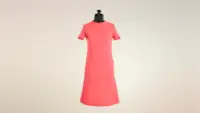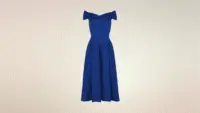Tutu dress

When and where was this item first created, and what practical purpose did it serve?
The tutu dress emerged in the early 1980s as fashion designers began translating ballet’s ethereal aesthetic into ready-to-wear clothing. This hybrid garment combined the structured bodice of traditional evening wear with the voluminous, layered skirt characteristic of classical ballet tutus. Unlike stage tutus which required precise engineering for dance movement, fashion tutu dresses prioritized visual drama and romantic silhouette.
The concept originated when New York designers began experimenting with tulle and crinoline to create fantasy garments that captured ballet’s otherworldly beauty. These dresses served a purely aesthetic purpose, transforming the wearer into a romantic figure reminiscent of classical ballerinas. The timing coincided perfectly with the 1980s fascination with theatrical fashion and the influence of dance culture on mainstream style.
Early versions appeared in high-end boutiques before trickling down to prom and formal wear markets. The tutu dress fulfilled women’s desires to embody grace and femininity while making bold fashion statements that reflected the decade’s embrace of dramatic, attention-grabbing silhouettes.
The concept originated when New York designers began experimenting with tulle and crinoline to create fantasy garments that captured ballet’s otherworldly beauty. These dresses served a purely aesthetic purpose, transforming the wearer into a romantic figure reminiscent of classical ballerinas. The timing coincided perfectly with the 1980s fascination with theatrical fashion and the influence of dance culture on mainstream style.
Early versions appeared in high-end boutiques before trickling down to prom and formal wear markets. The tutu dress fulfilled women’s desires to embody grace and femininity while making bold fashion statements that reflected the decade’s embrace of dramatic, attention-grabbing silhouettes.
What are the key design features and construction methods of this item?
Authentic tutu dresses feature multiple layers of soft tulle or net fabric gathered into a full, bell-shaped skirt that extends from a fitted bodice. The bodice typically incorporates boning or internal structure to create a smooth, supportive foundation that contrasts with the skirt’s airy volume. Traditional construction methods involve hand-sewing individual tulle layers to prevent the delicate fabric from tearing during attachment.
The skirt portion requires careful engineering to achieve proper fullness without excessive bulk at the waistline. Quality examples feature French seams or rolled hems on tulle edges to prevent fraying and maintain the ethereal appearance. The bodice construction often mirrors corsetry techniques with internal stays and precise fitting through the torso.
Authentic pieces typically measure between knee-length and floor-length, with the tulle layers cut in graduated lengths to create natural movement and visual depth. Professional construction includes adequate lining to prevent transparency while maintaining the dress’s lightweight feel. The waistline attachment represents a crucial construction point where the structured bodice meets the gathered skirt layers, requiring precise engineering to distribute weight and maintain the silhouette’s integrity throughout wear.
The skirt portion requires careful engineering to achieve proper fullness without excessive bulk at the waistline. Quality examples feature French seams or rolled hems on tulle edges to prevent fraying and maintain the ethereal appearance. The bodice construction often mirrors corsetry techniques with internal stays and precise fitting through the torso.
Authentic pieces typically measure between knee-length and floor-length, with the tulle layers cut in graduated lengths to create natural movement and visual depth. Professional construction includes adequate lining to prevent transparency while maintaining the dress’s lightweight feel. The waistline attachment represents a crucial construction point where the structured bodice meets the gathered skirt layers, requiring precise engineering to distribute weight and maintain the silhouette’s integrity throughout wear.
What cultural movements and social contexts featured this item?
The New Romantic movement of the early 1980s embraced theatrical fashion that blurred boundaries between costume and clothing, making tutu dresses perfect vehicles for this aesthetic rebellion. These garments became symbols of fantasy and escapism during an era when club culture celebrated dramatic, gender-fluid fashion statements. The punk and new wave scenes adopted tutu dresses as anti-establishment pieces that challenged conventional formal wear expectations.
Musicians and performers wore elaborate tutu-inspired creations to embody romantic, otherworldly personas that contrasted sharply with the decade’s emerging power dressing trends. The garments gained prominence in underground dance clubs where fashion served as performance art and personal expression. MTV’s influence helped popularize these fantastical styles as music videos showcased artists in elaborate tutu creations that captured viewers’ imaginations.
The movement’s emphasis on individual creativity and artistic self-expression made tutu dresses perfect canvases for personal styling experiments. Fashion magazines began featuring editorial spreads that presented tutu dresses as high fashion rather than costume pieces, legitimizing their place in contemporary wardrobes and establishing their cultural significance beyond theatrical contexts.
Musicians and performers wore elaborate tutu-inspired creations to embody romantic, otherworldly personas that contrasted sharply with the decade’s emerging power dressing trends. The garments gained prominence in underground dance clubs where fashion served as performance art and personal expression. MTV’s influence helped popularize these fantastical styles as music videos showcased artists in elaborate tutu creations that captured viewers’ imaginations.
The movement’s emphasis on individual creativity and artistic self-expression made tutu dresses perfect canvases for personal styling experiments. Fashion magazines began featuring editorial spreads that presented tutu dresses as high fashion rather than costume pieces, legitimizing their place in contemporary wardrobes and establishing their cultural significance beyond theatrical contexts.
Is this item still produced today, and how has it evolved over time?
Contemporary designers continue producing tutu-inspired dresses, though modern versions often feature simplified construction and alternative materials that reduce cost and maintenance requirements. Today’s interpretations typically incorporate synthetic tulles and machine-sewn construction methods that create similar visual effects with improved durability. High-end fashion houses periodically revisit the tutu dress concept for special collections, often reinterpreting the silhouette with luxury fabrics and contemporary proportions.
The influence persists in formal wear markets where abbreviated tutu-style skirts appear on prom dresses and cocktail wear. Modern bridal fashion frequently incorporates tutu elements as designers respond to brides seeking romantic, princess-inspired silhouettes. Fast fashion retailers produce simplified versions using basic tulle and standard dress construction, making the look accessible to broader audiences.
Contemporary dance wear companies now create street-appropriate tutu dresses that bridge the gap between performance costume and casual fashion. The original 1980s aesthetic continues influencing current designers who reference that era’s bold, theatrical approach to feminine dressing. Social media has revived interest in dramatic fashion statements, leading to renewed appreciation for tutu dresses among younger consumers seeking Instagram-worthy outfits that capture attention and express individuality.
The influence persists in formal wear markets where abbreviated tutu-style skirts appear on prom dresses and cocktail wear. Modern bridal fashion frequently incorporates tutu elements as designers respond to brides seeking romantic, princess-inspired silhouettes. Fast fashion retailers produce simplified versions using basic tulle and standard dress construction, making the look accessible to broader audiences.
Contemporary dance wear companies now create street-appropriate tutu dresses that bridge the gap between performance costume and casual fashion. The original 1980s aesthetic continues influencing current designers who reference that era’s bold, theatrical approach to feminine dressing. Social media has revived interest in dramatic fashion statements, leading to renewed appreciation for tutu dresses among younger consumers seeking Instagram-worthy outfits that capture attention and express individuality.
How do you identify authentic vintage versions of this item?
Authentic 1980s tutu dresses feature specific tulle types including silk tulle, cotton tulle, or early synthetic blends that create characteristic draping patterns distinct from modern synthetic alternatives. Original construction shows hand-finished seams on delicate tulle layers, with French seams or carefully rolled edges that prevent the telltale fraying seen in machine-finished reproductions. Period pieces display natural aging in the tulle fabric, which develops a slightly matte finish and softer texture over time, contrasting with the crisp, shiny appearance of new synthetic materials.
Authentic examples feature internal construction typical of 1980s formal wear, including plastic or metal boning in the bodice and period-appropriate zipper types and placement. Original labels from established eveningwear manufacturers, specialty boutiques, or department stores provide crucial dating evidence, as do union labels reflecting 1980s manufacturing practices. Quality indicators include substantial lining fabrics, professional-grade interfacing, and attention to finishing details that reflected the era’s investment in special occasion garments.
Proportional relationships reveal period-specific fit preferences with higher waistlines, broader shoulders, and fuller skirt volumes than contemporary reproductions. Construction weight and fabric density distinguish authentic pieces from modern interpretations, which typically use lighter materials and simplified internal structure to reduce manufacturing costs while mimicking the original silhouette.
Authentic examples feature internal construction typical of 1980s formal wear, including plastic or metal boning in the bodice and period-appropriate zipper types and placement. Original labels from established eveningwear manufacturers, specialty boutiques, or department stores provide crucial dating evidence, as do union labels reflecting 1980s manufacturing practices. Quality indicators include substantial lining fabrics, professional-grade interfacing, and attention to finishing details that reflected the era’s investment in special occasion garments.
Proportional relationships reveal period-specific fit preferences with higher waistlines, broader shoulders, and fuller skirt volumes than contemporary reproductions. Construction weight and fabric density distinguish authentic pieces from modern interpretations, which typically use lighter materials and simplified internal structure to reduce manufacturing costs while mimicking the original silhouette.


